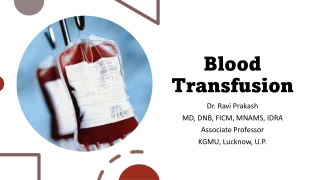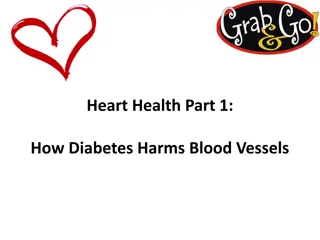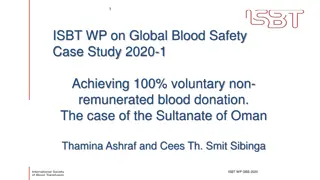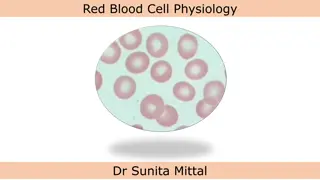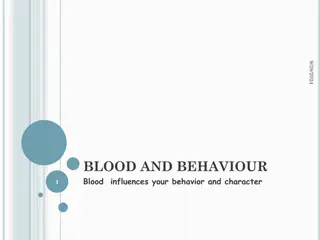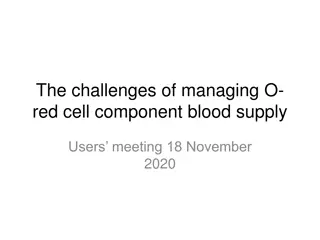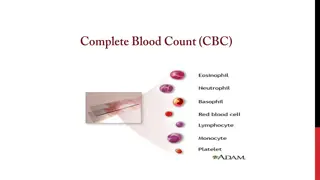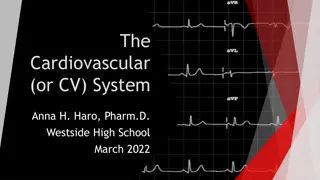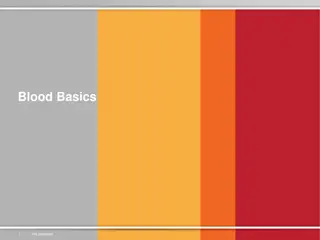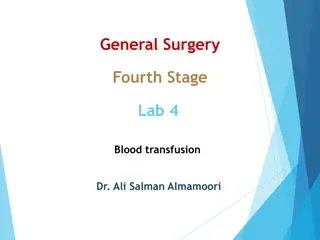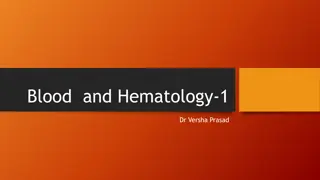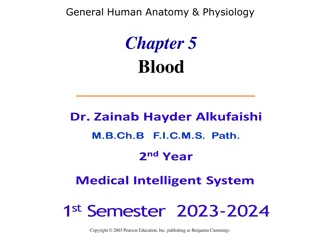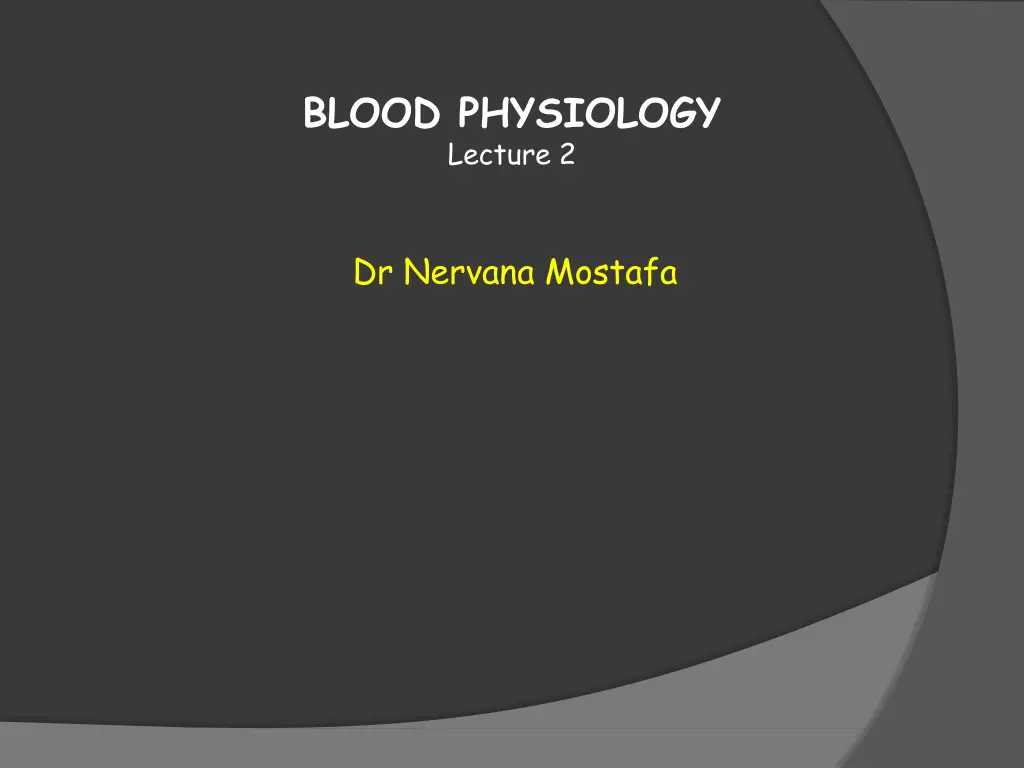
Understanding Blood Physiology: Essential Elements for RBC Formation and Functions
Explore the crucial aspects of blood physiology in this lecture, covering topics like RBC formation, Vit B12 absorption, hemoglobin structure, iron metabolism, anemia, and polycythemia. Discover the essential elements required for RBC maturation and the consequences of deficiencies in vitamins and hormones. Dive into the world of blood physiology and enhance your knowledge in this field.
Download Presentation

Please find below an Image/Link to download the presentation.
The content on the website is provided AS IS for your information and personal use only. It may not be sold, licensed, or shared on other websites without obtaining consent from the author. If you encounter any issues during the download, it is possible that the publisher has removed the file from their server.
You are allowed to download the files provided on this website for personal or commercial use, subject to the condition that they are used lawfully. All files are the property of their respective owners.
The content on the website is provided AS IS for your information and personal use only. It may not be sold, licensed, or shared on other websites without obtaining consent from the author.
E N D
Presentation Transcript
BLOOD PHYSIOLOGY Lecture 2 Dr Nervana Mostafa
Objectives At the end of this lecture you should be able to: 1. Describe essential elements needed for RBC formation. 2. Describe the process of Vit B12 absorption and its malabsorption. 3. Recognize haemaglobin structure and its functions. 4. Discuss iron metabolism (absorption, storage and transport) 2
Objectives cont. 5. Describe the fate of old RBC. 6. Describe anemia and its causes. 7. Recognize causes of polycythemia. 3
Topics: 1. Essential elements for RBC formation Proteins Vitamins: B12, Folic acid, Vit C ) Iron Metabolism. 2. Anemia 3. Polycythemia 4. Structure & functions of Hb
Essential elements for RBCs formation and Maturation Certain elements are essential for RBC formation and maturation: Amino acids: formation of globin in haemoglobin sever protein deficiency 1. anaemia Iron: formation of haemoglobin Deficiency anaemia 2. 5
Essential elements for RBCs formation and Maturation cont. Vitamins: Vit B12 and Folic acid Deficiency Other :Vit B6, Riboflavin, nicotinic acid, biotin, Vit C, Vit E 3. Synthesis of nucleoprotein anemia Essential elements Copper, Cobalt, zinc, manganese 4. Hormones Androgens, Thyroid, cortisol & growth hormones Deficiencies of any one results in anaemia 5. 7
V Vitam itami in n B B12 12 & & F Folic olic acid acid Important for DNA synthesis and final maturation of RBC. Dietary source: meat, milk, liver, fat, green vegetables. Deficiency leads to: Failure of nuclear maturation & division Abnormally large & oval shape RBC Short life span reduced RBC count & Hb Macrocytic (megaloblastic) anemia 8
Macrocytic anemia Note the hypersegmented neurotrophil and also that the RBC are almost as large as the lymphocyte. Finally, note that there are fewer RBCs.
Microcytic hypochromic anemia - The RBC's are smaller than normal and have an increased zone of central pallor. - This is indicative of a microcytic (smaller size of each RBC) and hypochromic (less hemoglobin in each RBC) anemia. - There is also increased anisocytosis (variation in size) and poikilocytosis (variation in shape).
ANAEMIAS Definiation Decrease number of RBC Decrease Hb Symptoms: Tired, Fatigue, short of breath, heart failure. 12
Causes of anaemia 1.Blood Loss acute Chronic accident (RBC return to normal 3-6w) microcytic hypochromic anaema (ulcer, worms) 2.Decrease RBC production Nutritional causes: Iron microcytic hypochromic anaemia. Vit B12 & Folic acid megaloblastic anaemia . Bone marrow failure: destruction by cancer, radiation, drugs Aplastic anaemia. 3.Haemolytic Abnormal cells or Hb Spherocytosis sickle cells Incompatible blood transfusion. Erythroblastosis fetalis . excessive destruction
Polycythemia Increased number of RBC Types: Primary (Polycythemia Rubra Vera - PRV): uncontrolled RBC production. 1. Secondary to hypoxia: high altitude (physiological), chronic respiratory or cardiac disease 2. 14
HAEMOGLOBIN Hb molecules consist 4 chains each formed of heme & polypeptide chain (globin) Heme consist of protoporphyrin iron (F2+) ring + 15
Types of normal Hb.: -HbA(2 & 2 beta chains) (adult Hb) (98%). - HbA2 (2 & 2 delta chains) (2%) -Hb F (2 & 2 chains) (Hb of intrauterine life). -Abnormality in the polypeptide chain - abnormal Hb (hemoglobinopathies) e.g thalassemias, sickle cell (HbS).
Functions of Hemoglobin Carriage of O2 Hb reversibly bind O2to form oxyhemoglobin, affect by pH, temperatre, H+ Carriage of CO2 Hb bind CO2= carboxyhemaglobin Buffer 25
Malabsorption of Vit. B12 Pernicious Anemia VB12 absorption needs intrinsic factor secreted by parietal cells of stomach. VB12 + intrinsic factor is absorbed in the terminal Ileum. Deficiency arise from (Causes of deficiencies): Inadequate intake Poor absorption due to Intestinal disease 18
Iron metabolism (Fe) Iron is needed for the synthesis of haemoglobin, myoglobin cytochrome oxsidase, peroxidase & catalase Total Iron in the body = 4-5g 65% .. Haemoglobin 5% .. other hems 1% . bound to transferrin (betaglobulin) in blood 15-30% stored iron in the form of ferritin in the liver, spleen and bone marrow. 19
Iron absorption Iron in food mostly in oxidized form (Ferric, F+3) Better absorbed in reduced form (Ferrous, F+2) Iron in stomach is reduced by gastric acid, Vitamin C. Rate of iron absorption depend on the amount of iron stored 20
Transport and storage of iron Iron is transport in plasma in the form of Transferrin (apotransferrin + iron). Iron is stored in two forms: Ferritin (apoferritin + iron) Haemosiderin (insoluble complex molecule, in liver, spleen, bone marrow) Daily loss of iron is 0.6 mg in male & 1.3mg/day in females. 21
Destruction of RBC RBC life span in circulation = 120 days. Metabolic active cells. Old cell has a fragile cell membrane, cell will rupture as it passes in narrow capillaries (and spleen). Released Hb is taken up by macrophages in liver, spleen & bone marrow: Hb is broken into its component: Polypeptide amino acids (protein pool = storage) Iron ---- ferrtin Haem (Porphyrin)>> bilirubin>> secreted by the liver into bile. [excess destruction of RBC Jaundice] 22

